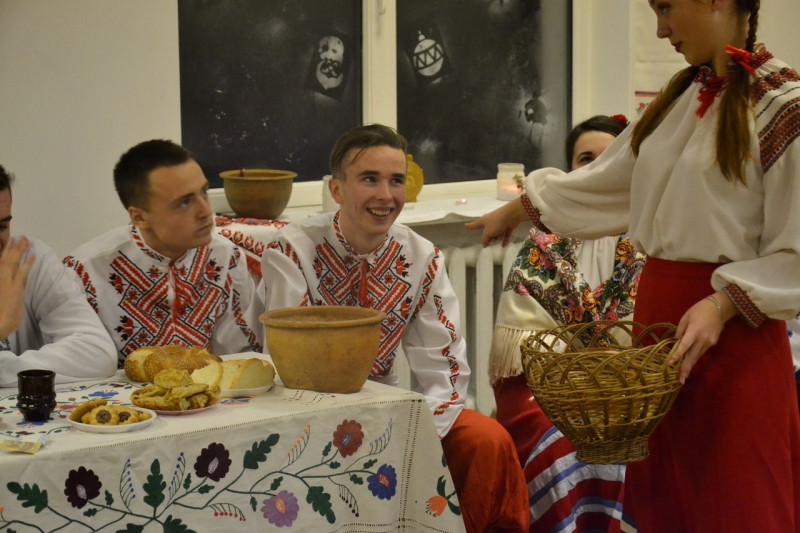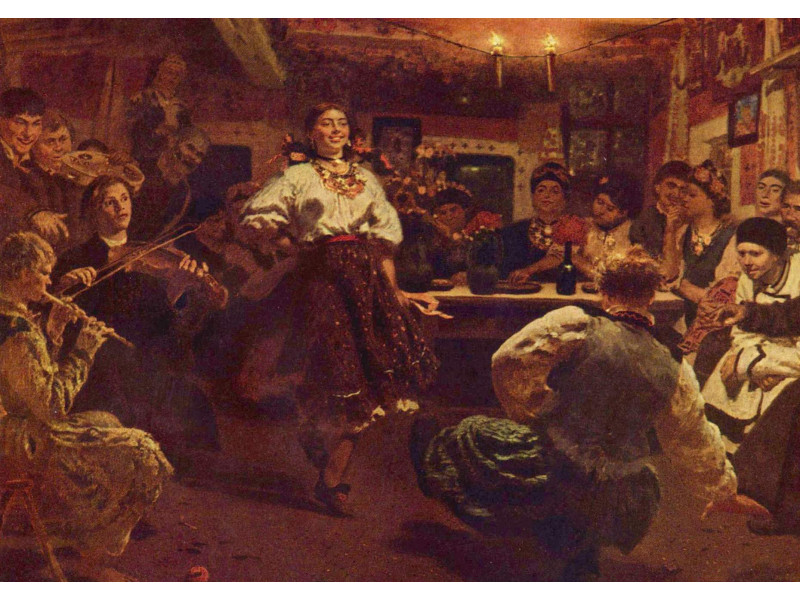A century ago, in Ukrainian villages one could see examples of ancient entertainments of rural youth: streets, music, evening parties, parties, dosvetki, grishcha, dropryakhi, odenks, etc.
The most colorful entertainment for young people were evening parties. Traditionally, they began on Pokrova, when work in the garden ended, the nights became longer, and there was plenty of time for work under the roof.

Traditionally, evening parties were held in the home of an elderly woman, widow, or conscript. The girls' community would arrange with the hostess to hold evening parties in her home. The evening party (after-party) mother played the role of a duenja at the evening parties, and was supposed to keep an eye on the youth (however, she often turned a blind eye to certain things).
In large villages, there could be several vechornytsia centers. Often, in one corner, vechornytsia for adults (17–18 years old) and younger ones (up to 16 years old) could take place, in separate houses. Brothers and sisters went to different vechornytsia. Depending on the size, 5–15 girls and about 20 boys could gather in one house. Traditionally, girls stuck to their community and did not go to other vechornytsia centers, but boys, in search of better brides, often visited vechornytsia in other villages (but they had to have an agreement with the local young men: they could also give a flogging for their girls, and girls' communities could not let strangers into their vechornytsia).
It was mainly girls who prepared the house for the evening parties. They took care of the firewood and lighting (lamps, candles, etc. Only in cases where the house was to be lit with kerosene did the boys also monitor its availability). They also took care of the food (a certain amount of food was left for the evening party mother - this was a thank you for allowing us to gather in her home), and on certain days the girls spun for the evening party mother or helped out in groups around the house.
Ukrainian evenings were not of the same type: they were divided into festive (Sunday, wedding, farewell and holiday) and everyday (after-dawn). Evenings were a real school for a young housewife: here girls learned to sew, spin, cook and learn various wisdoms from their after-dawn mothers. The knowledge that a girl did not master from her mother, she had a chance to learn at evenings.
At everyday parties, girls most often spun, sewed, and embroidered, but there was also plenty of entertainment (songs, scary stories, gossip). The girls did their work diligently, because they had to show their mothers what they had made in the morning. The boys came to the parties later. They carried homemade instruments (pipes, violins, mandolins, etc.) and treats (nuts, seeds, gingerbread). Sometimes the local gang of young men was joined by boys from neighboring villages (they looked to see which girls were prettier and more hardworking). The boys at the parties could also work: they wove harnesses or mittens, repaired harnesses, but most often they just sat and courted the girls, entertaining them with witty stories, jokes, and music. Sometimes they sat down to play cards: fool, trump, pig, witch, etc. (they didn't play for money - they could play for wishes or tricks). The parties lasted until midnight – then the majority went home (the guys saw the girls off), and some (mostly couples) stayed overnight at the mother's house until dawn.

At festive evenings, young people rested and had fun. Musicians were invited (if there was not enough money, they played on improvised objects: spoons, rubles and pots), there were dances, games, fun games. At festive evenings, people wore the best clothes, prepared festive dishes (depending on the holiday). A special feature of festive evenings was the folding: girls folded with products brought from home, boys - with money. With this money, musicians were hired, and delicacies and drinks were bought.
Wedding parties were our Ukrainian bachelorette parties. The bride's girlfriends gathered, sang sad songs about saying goodbye to her maidenhood. Young women and older women were also present at these parties. They shared their life experiences with the girls. And at these parties, the future wife was helped with the preparation of the chest (if she did not sew enough, her friends would prepare everything she needed). Bachelorette parties were more fun: the young man said goodbye to freedom and entertainment. After all, as the head of the family, he had to take on a significant amount of new responsibilities.
Recruit parties (or farewell parties) had a number of their own peculiarities: the main attention was drawn to the future recruit. Everyone tried to entertain him, to lighten his burden. The girls prepared the best dishes, there was cheerful music, they danced incendiary dances. The recruit was tied an embroidered towel as a reminder of home, where they were waiting for him.

Special types of festive parties were the feast parties: here a festive flavor was added to the party. For example, St. Andrew's parties with fortune telling, traditional dishes and rituals (biting a piece of kalita, sculpting dumplings, sowing hemp, fortune telling on shoes and balabushki, etc.). Girls and boys used to tell fortunes together, but young men (in some regions) tried to interfere with certain girlish rituals or even play them to their own advantage. A special part of the St. Andrew's festivities was the rite of biting a piece of kalita. This rite was a kind of test of maturity: it was important not only to bite off a piece of the cake, but also to restrain one's emotions, not to laugh. It was believed that those who abstained would get married, while those who laughed would remain bachelors and bachelorettes for another year, because they were not yet adults (and those who laughed while biting the kalita were smeared with soot).
The festivities ended with dinner. After dinner, dancing began (except in those centers where fasting was observed - there the festivities were held without dancing and with lean meals). The fun sometimes lasted all night. After the evening parties, people went home. The girls continued to tell fortunes: they put combs, bindis, hoods, pieces of paper with the names of the guys under their pillows, and also put a twig - if it bloomed by January 13, then they should expect matchmakers this year.
The season of vespers ended before Christmas, in some regions during the “cheese week” before Easter Lent. The young people thanked the hostess who hosted the vespers, and said goodbye to the vespers until the following fall.
However, the fun did not stop there. After the end of the Easter fast, when work began in the fields and gardens, the young people had little time for entertainment. However, from time to time, young people gathered for dances and festivities (the so-called "street"), for Green Holidays and Kupala.
Now you can see traditional festivities of Ukrainian youth only at festivals and events at museums (for example, the Honchar Museum prepares an event for Andriy every year), and such an element of evening parties as folk dances - at the same festivals and at master classes from folk dance schools (by the way, you can see them and take part in them on Tuesdays and Wednesdays from 7:00 PM in the courtyard of the Honchar Museum (Arsenalna metro station, Lavrska St., 19).


Write a comment